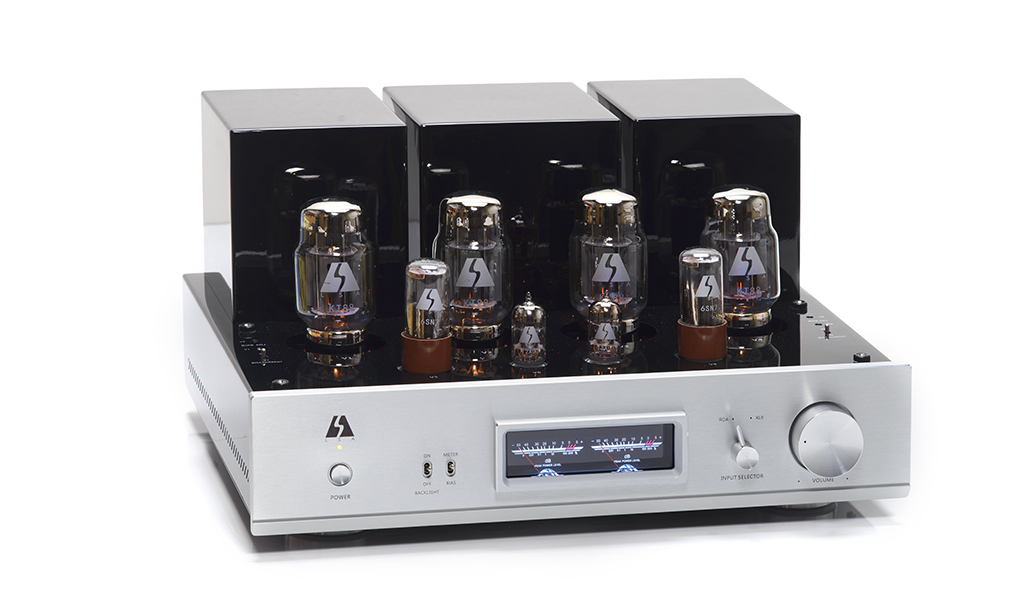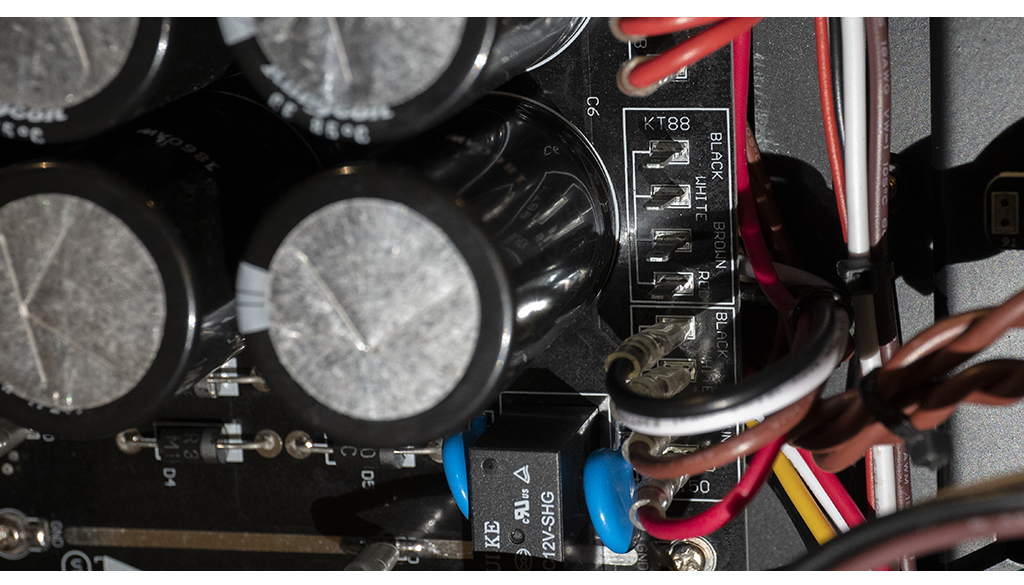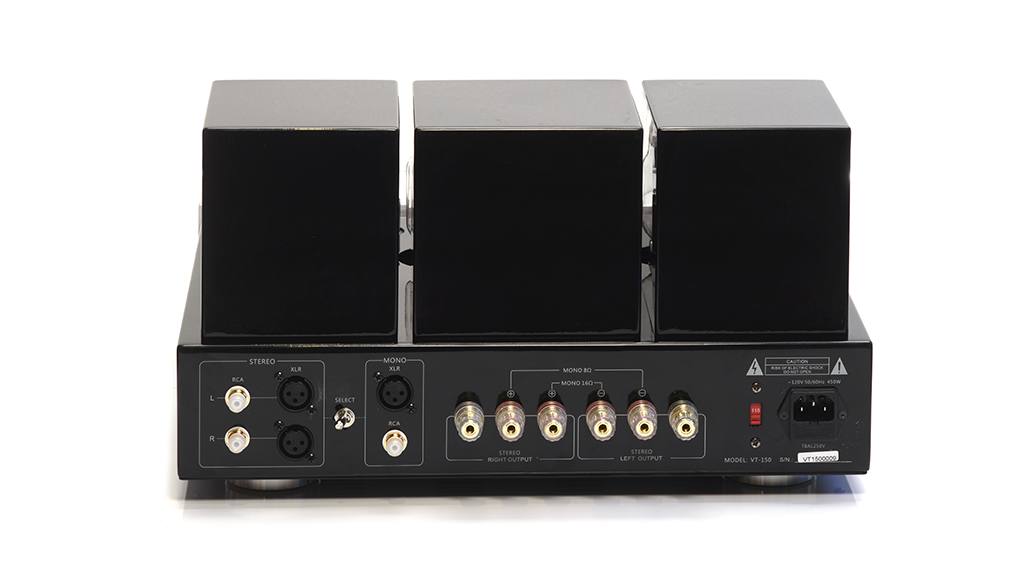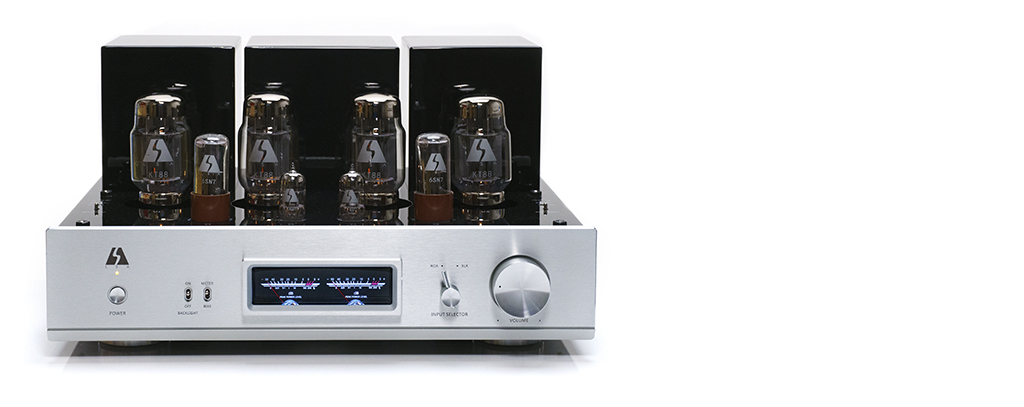The LSA VT-150 Integrated When you need MORE power
By Jeff Dorgay
With the backlit output meters bouncing to the sound of Massive Attack, cranking up the VT-150s bias to the “high” position and plugging in a set of KT150 tubes proves to be a great move to get that club feeling. Our Team Fink Kim speakers are relatively easy to drive and taking advantage of their variable damping factor technology allows an incredibly good matchup to this tube amplifier, delivering solid bass.
Both Jerold O’Brien and I really enjoy the lower powered VT-70 from LSA. It’s a great entry level tube integrated that ticks all the boxes. Good build quality, great sound, and tubes that are relatively easy to come by. However, if you’re a tube lover, you know a pair of EL34 output tubes can only take you so far – lovely if you can live with 35 Watts per channel, but not the right tool for the job if you have speakers that require more power to do their thing. Or, you really like it LOUD.
Variable output
VSA now gives you a way to get more power, and if you use this amplifier as a monoblock, way more power. And options, you like options, don’t you? While you can drop a set of KT88s in the VT-70 and crank up the bias a bit, it won’t deliver that much more power, but the VT-150 thanks to its larger power supply and more robust output transformers (and more weight…) will deliver 60 Watts per channel in stereo mode at the lower bias setting.
Where PrimaLuna offers this as a switch-controlled function on some of their EVO amplifiers, the higher-powered options on the VT-150 require some manual labor. But this is what gets you a 60-100 Watt per channel integrated for an introductory price of $2,499. If you aren’t constantly tube rolling, this won’t be an issue.
Should you desire 80 Watts per channel, or even 100 Watts per channel with a set of KT150 tubes, the bottom cover can be removed, and jumpers replaced to supply the output tubes with the necessary current to deliver the additional power. Keep in mind, running the KT88s (or KT120s, if you go that route) at the higher bias results in shorter tube life. It’s easy enough to see what you prefer and set your VT-150 that way. If 60 Watts per channel gives you enough juice to light your speakers up, stick with the low bias setting and enjoy longer tube life.

Whether you are new to tubes, or familiar with the breed, biasing the output tubes is very easy – the output meters double as a bias indicator. Take a quick peek at the well written manual and follow the instructions. You’ll be an expert in no time. As with any tube amplifier, re-check the tube bias again after a week or two and then in a month. After that a cursory look should be all you need, the tubes should not shift much after the first 30 days or so. When you can no longer bring them to full bias anymore, it’s time to replace.
Basic configuration
Where the VT-70 offers a basic remote control, the VT-150 is no frills and no remote. Where the VT-70 offers three single-ended RCA inputs, the VT-150 has one RCA input and one XLR. Around back, you’ll see a switch that turns the amplifier into a monoblock, and delivering more power. Instead of having 4 and 8-ohm speaker taps the VT-150 now has 8- and 16-ohm taps. None of the speakers on hand for the review had major impedance drops so there were no issues with this amplifier in stereo mode.
For those seeking the maximum amount of sonic engagement with the least number of superfluous additions, the VT-150 is the way to roll. They’ve eliminated the remote control, no LED light in the volume control, and have kept all functionality to the bare minimum. The front panel is nicely finished, as is the volume control and chassis – an amplifier you’ll be proud to own, no doubt.
However, when producing product at this price point, every ten dollars affects the bottom line. In this case, the frills eliminated have been put into the quality of the output transformers and the components underneath the chassis. A few other tube integrateds offer completely point to point wiring, where the VT-150 has a mixture – they are all way more expensive. Careful listening reveals this amplifier is without sonic compromise, at this price. Considering that the McIntosh LB200 with optional rack mount handles will set you back $2,000 and it’s only a light box, the VT-150 must be one of the most stellar values in high end audio. Another $500 gets you a 80 Wpc integrated amp! Woo hoo.
More about tubes
The VT-150 arrives with a tube cage in place, but if you can avoid using it, few things in audio beat a bunch of glowing tubes. Much attention has been given to the output tube choices at your disposal with this amplifier, but thanks to the input/preamplifier stage using a pair of 6SN7 and 12AU7 tubes, you can tube roll to infinity.
Manufacturers rarely want us to discuss the benefits of tube rolling, especially substituting NOS tubes because this is not a consistent item, and often without repeatable results. Hence, manufacturers tend to design around tubes that are readily available. However, this amplifier circuit is well designed, and should the urge strike to swap tubes, there are sonic rewards to be had. It will depend on how maniacal you choose to be, but let it be said that should you feel like chasing down a few primo 12AU7s and 6SN7s (or maybe have some on hand already) it’s worth your while to experiment.
Ditto for the output tubes. The KT120 is not my favorite output tube, as it tends to sound more etched, but that doesn’t mean it won’t be the perfect match in your system with your speakers. Leave bias jumpers at the lower setting and set bias to the higher end of the range. The KT150s will deliver the most output, however the presentation is a different one than the KT88s produce.
When driving a pair of vintage Acoustat 2+2 speakers, the extra output and high-end snap, along with a pair of Nordost speaker cables brought those old ESLs to life in a way that’s never been done with a modest tube amp. When driving the XSA Vanguard speakers, the KT88s even at the lower bias setting is incredibly engaging. Finally, keep in mind that the amplifier sounds great out of the box. Tube rolling is not a necessity; however, this amplifier responds well to small changes. So to be clear, the VT-150 delivers top performance out of the box with the stock, factory supplied tubes, however those inclined to investigate premium tubes will be rewarded as well. This great for two reasons: it gives you a chance to easily improve your system as your involvement grows, and it shows a circuit that has been designed beyond meeting its immediate price point.
The finer points

Because the VT-150 uses a pair of input transformers to offer balanced inputs, this input will provide a slightly warmer, less dynamic sound than the RCA inputs will. The upside is this amplifiers’ ability to be fine-tuned to your music collection and/or listening habits. These are miniscule differences but make a difference nonetheless when using a balanced source.
Listening to the VT-70 and 150 side by side for some time, it’s important to point out that you are not merely getting more power when stepping up. More refinement awaits you with the VT-150 too, a sign of great designs. The bigger amplifier is more composed on top, more controlled on the bottom, and it resolves a decent share of increased inner detail too.
The VT-150 produces a very clean, fast, detailed look into the window of your favorite recordings. Comparing it to more expensive amplifiers on hand from Audio Research, BAT, Octave, and PrimaLuna, the VT-150 holds its ground. It is not a giant killer. The refinement afforded by the 10-20k amplifiers is still supreme. However, the way this amplifier nails all the musical basics at an equally commanding level will surprise you.
Tracking through a wide variety of different music is a joy with the VT-150. It is dynamic enough to play classical music or heavy rock as loud as you need yet offers great linearity at lower volumes. Even listening to the CSN debut album on MoFi at very low levels with the Dynaudio Confidence 20s is incredibly engaging. Yet cranking the volume way up for some Public Enemy and Slayer proves it delivers the goods.
in addition to having solid, controlled extension on both ends of the frequency scale, this amplifier can generate a large sound field in all three dimensions. There’s a lot of “vacuum tube magic” going on here, to be sure.
And, putting a $2,500-$3,000 amplifier in the context of the $7,500 to $15k system it is more than likely going to end up in will leave you thrilled with the purchase. If you’ve been dreaming of investigating a tube amplifier, I can think of no better place to start your journey. Perhaps at some point, we will commandeer a second one to investigate how these perform as monoblocks. For now, staffer Jerold O’Brien will be using this one on a daily. His daughter took the VT-70, so how can you argue with that?
Highly recommended.

The LSA VT-150
$2,999 (intro price $2,499)
underwoodhifi.com/products/lsa-amplifiers
PERIPHERALS
Digital source Naim CD-5is, T+A 2500R
Analog source Technics SL-1200G/Skyanalog G-1 cartridge
Phono Pre BAT VK-12SE
Speakers Dynaudio Confidence 20, Acoustat 2+2, Egglestonworks Nico
Cable Tellurium Q Black II



